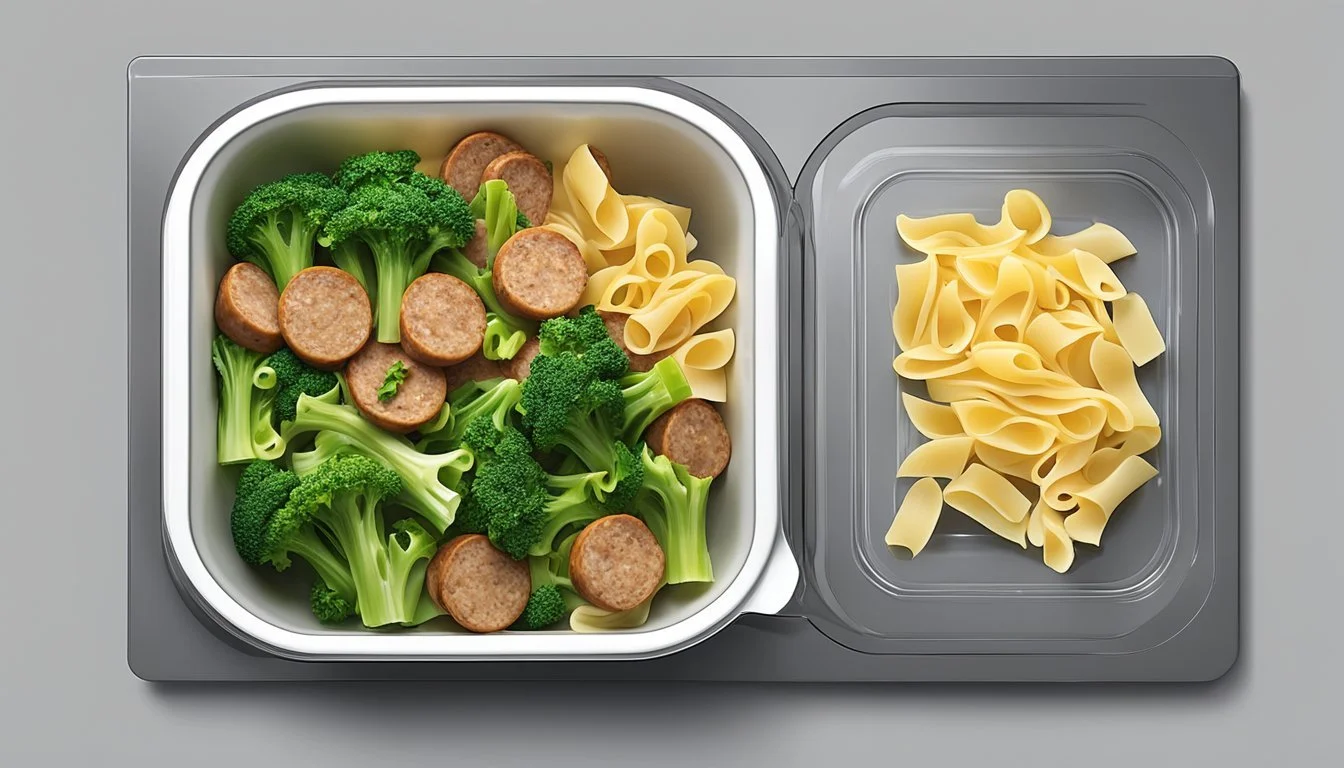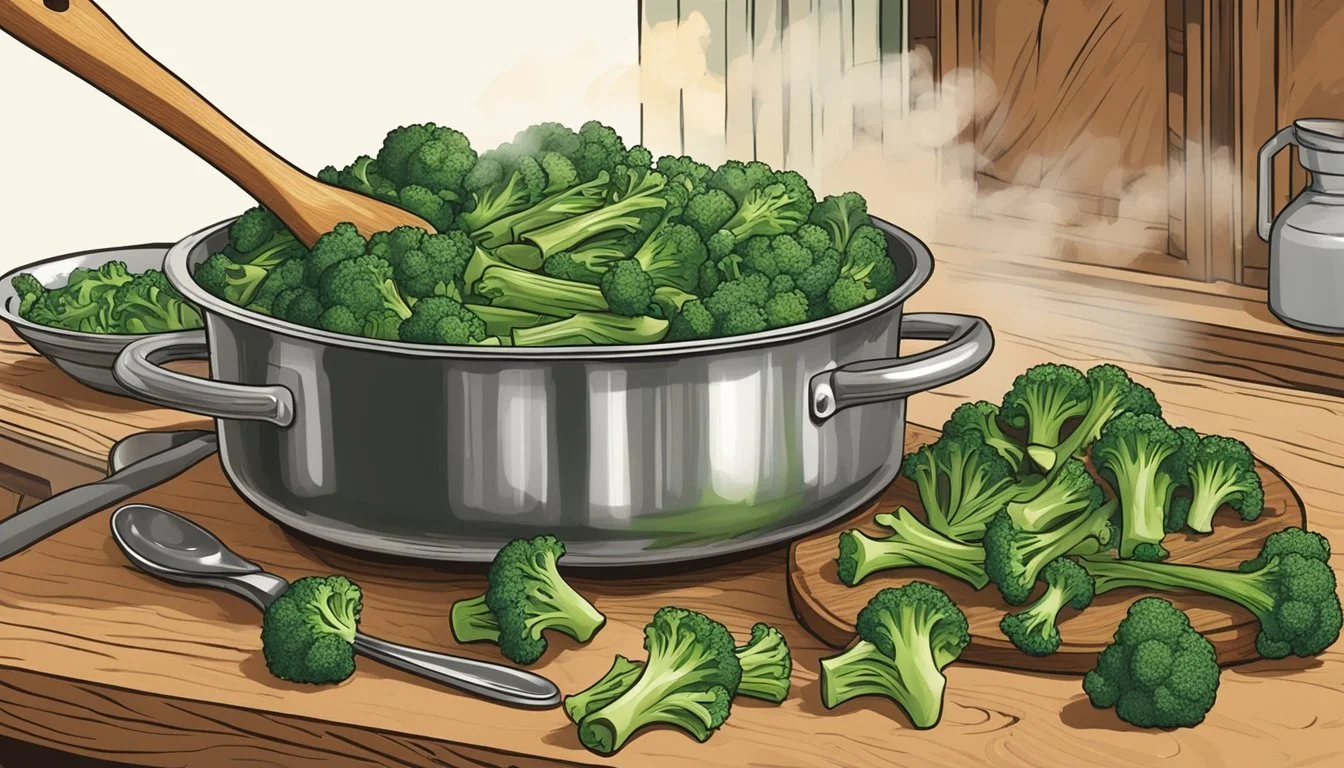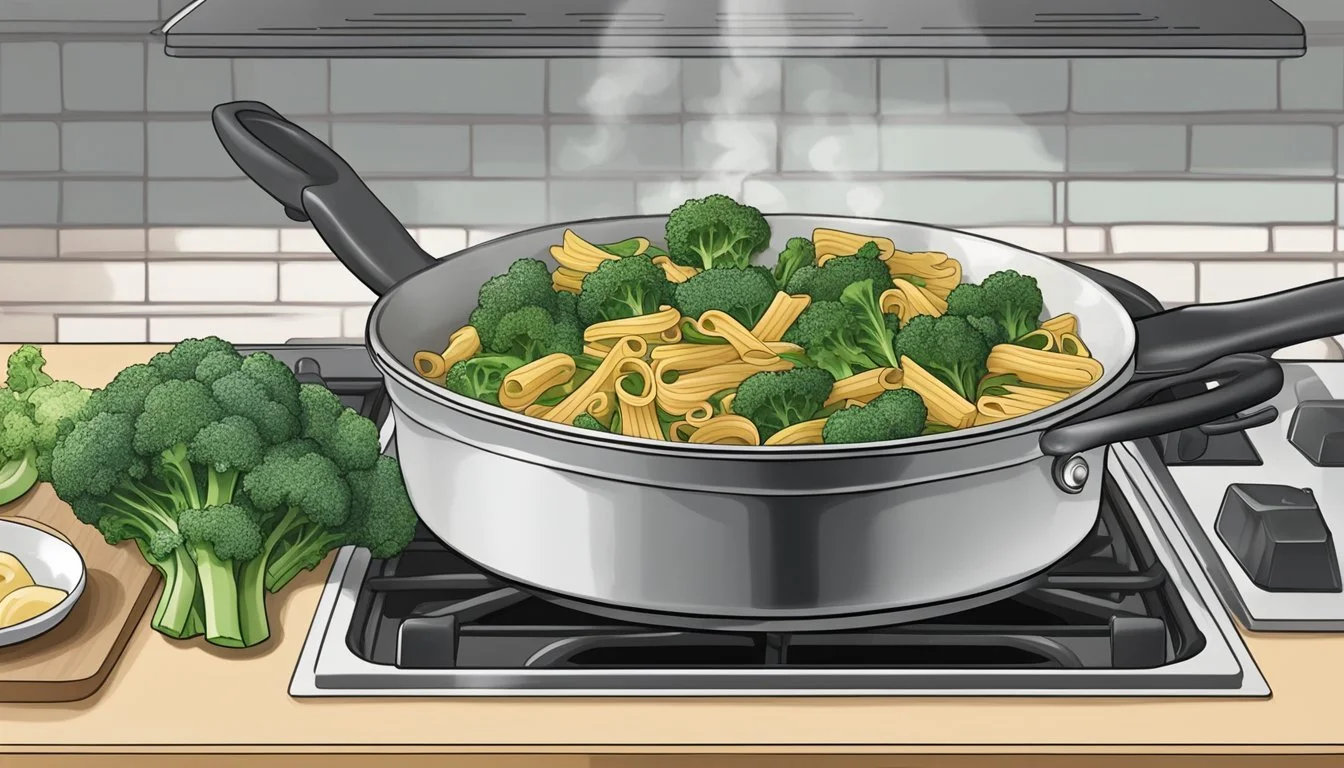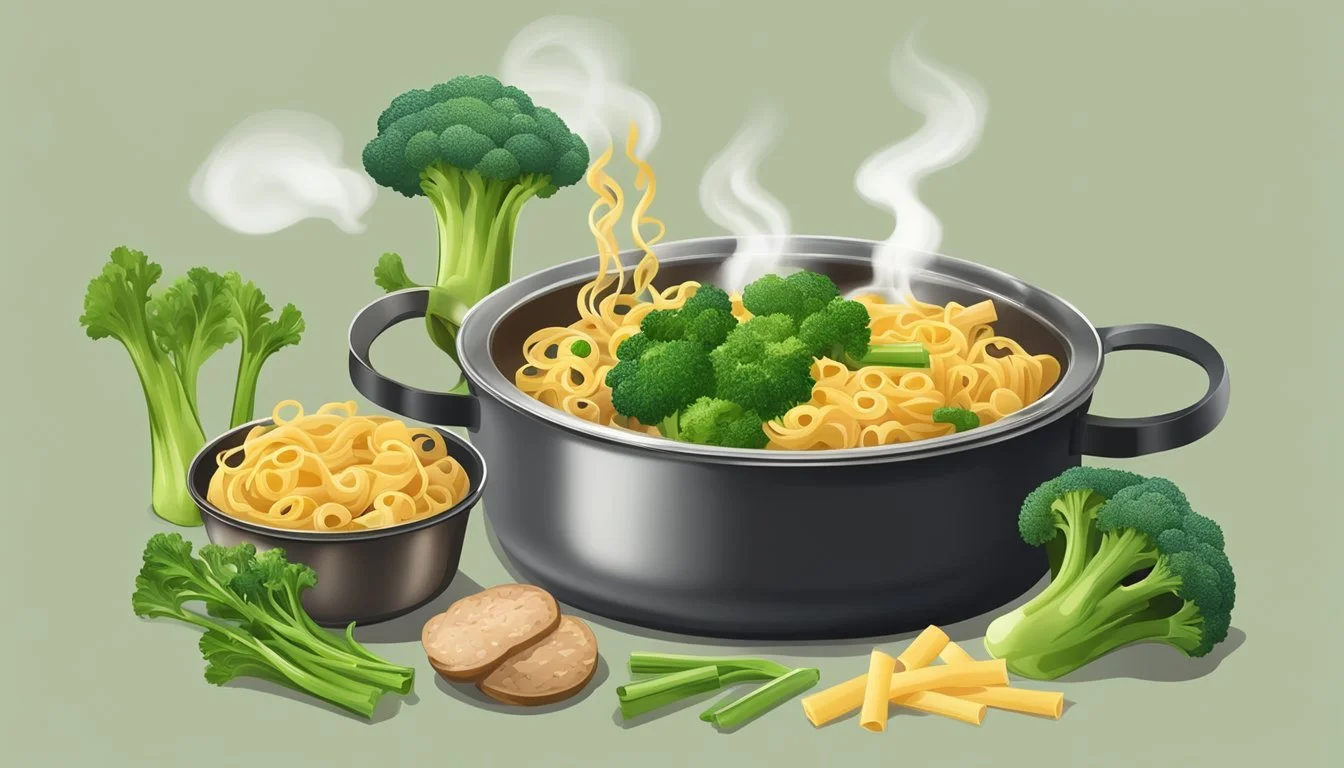Best Way to Reheat Broccoli Rabe and Sausage Pasta
Ensuring Tender Greens Every Time
Broccoli rabe and sausage pasta (What wine goes well with pasta?) embodies the robust flavors of Italian cuisine, offering a delicious combination of bitter greens and savory meat. Both ingredients hold a valued place in the nutritional profile of Mediterranean dishes, with broccoli rabe providing essential vitamins and antioxidants, and sausage delivering satisfying protein. When it comes to enjoying leftovers, the challenge often lies in reheating the dish without compromising the texture of the greens or the juiciness of the sausage.
Reheating this dish requires a gentle touch to maintain the tenderness of the broccoli rabe and ensure that the pasta and sausage remain flavorful. The key is to apply a method that warms the meal through without causing the broccoli rabe to become overcooked or the sausage to dry out. This balance is crucial to retain the dish's distinct taste and nutritional benefits.
The nutritional profile of the dish is also an important consideration, as the reheating process should preserve the healthful qualities of the ingredients. Broccoli rabe, with its rich supply of vitamins and minerals, should maintain its integrity, while the protein in the sausage is best enjoyed when it’s warmed to the right temperature. The right reheating technique elevates the experience of savoring this Italian staple, ensuring that the second serving is as enjoyable as the first.
Understanding the Components
Reheating Broccoli Rabe and Sausage Pasta requires attention to the properties of its individual ingredients to maintain optimal flavor and texture. The pasta, sausage, and broccoli rabe each play a pivotal role and should be handled with care to ensure a satisfying meal.
Pasta Varieties
Orecchiette is a short pasta ideally shaped for holding sauces and small pieces of food, making it a preferred choice for broccoli rabe and sausage pasta dishes (What wine goes well with pasta dishes?). The small cup-like shape allows for an even distribution of flavor with each bite. For reheating, the pasta should retain its al dente texture without becoming mushy.
Types of Sausage
Sausage selection can vary dramatically, from Italian Sausage to other variants such as Chicken Sausage or Turkey Sausage. Italian sausages are traditionally made from pork and can range from sweet to spicy, including Spicy Italian Sausage. The choice of sausage affects the overall heat and flavor profile of the dish. When reheating, it's important to preserve the sausage's juiciness and seasoning.
Broccoli Rabe, aka Rapini
Broccoli Rabe, also known as rapini, is a bitter green that complements the richness of the sausage. When reheating, the goal is to maintain its tender texture without it becoming overcooked or excessively wilted. Broccoli rabe is often sautéed in olive oil and should be heated just enough to warm through, preserving its vibrant color and slight crunch.
Prepping for Reheating
Proper preparation of leftovers is essential for maintaining the quality of sausage pasta with broccoli rabe. This involves storing components correctly and understanding the blanching process for the greens.
Storing Leftovers Properly
To ensure broccoli rabe and sausage pasta remains as fresh as possible, leftovers should be stored in airtight containers. Refrigeration is key: the pasta and broccoli rabe mixture must be refrigerated at a temperature below 40°F (4°C) to slow bacterial growth and preserve its flavors and textures.
Container: Use airtight containers.
Temperature: Store below 40°F (4°C).
Separation: Consider storing pasta and broccoli rabe separately to prevent the greens from getting soggy.
Blanching Broccoli Rabe
If broccoli rabe was not blanched before incorporating it into the pasta, doing so before reheating can help maintain tenderness and minimize bitterness.
Preparing Cooking Water:
Bring a pot of water to a boil.
Add salt to the water to help season the rapini.
Blanching:
Submerge broccoli rabe in boiling water for about one to two minutes.
They should be bright green and slightly tender.
Shock in Cold Water:
After blanching, transfer the rapini immediately to a bowl of ice water.
This halts the cooking process, preserving color and texture.
Storing after Blanching:
Drain the rapini well.
Store it in an airtight container in the refrigerator.
By following these steps, the quality of broccoli rabe is kept optimal, ensuring that it reheats well alongside the sausage pasta for a delicious second serving.
Reheating Methodologies
To maintain the delicate texture of broccoli rabe and the succulence of sausage in pasta dishes, choosing the right reheating method is crucial. Both the oven and skillet can offer satisfactory results when used correctly.
Using the Oven
For oven reheating, one must ensure that the pasta doesn’t dry out while warming through. Here's a step-by-step guide for using the oven:
Preheat the oven to 350°F (175°C).
Place the broccoli rabe and sausage pasta in an oven-safe dish to avoid direct heat damaging the greens.
Drizzle with olive oil to keep the mixture moist and enhance flavor.
Cover the dish with foil to trap moisture and prevent the pasta and greens from drying out during reheating.
Heat for about 10-15 minutes or until completely warmed through. Check periodically to ensure the dish is heating evenly and not becoming too dry.
Skillet Reheating
A skillet can offer a quicker option for reheating while preserving moisture and texture:
Heat a skillet over medium heat.
Add a small amount of olive oil to prevent the pasta and sausage from sticking to the pan.
Once hot, transfer the pasta into the skillet, layering it evenly for uniform heating.
Stir occasionally, allowing the greens to warm up without wilting excessively.
Sprinkle a tiny amount of water if needed to reintroduce moisture and prevent drying out. Reheat for about 5-7 minutes or until the dish reaches the desired temperature.
Maintaining Texture and Flavor
When reheating broccoli rabe and sausage pasta, the aim is to retain the vibrant texture of the greens and the robust flavor of the dish. The method of reheating can significantly impact the mouthfeel and enjoyment of the meal.
Sautéing Greens
The process of sautéing is particularly effective for reheating broccoli rabe. To maintain the greens' texture, they should be sautéed over medium heat for a brief period. Broccoli rabe tends to have a naturally bitter taste, which can be mellowed through careful sautéing. This method heats the greens evenly, ensuring that they remain tender and not overly wilted, which could compromise their appealing mouthfeel.
Adding Freshness with Garlic and Olive Oil
Infusing the dish with garlic and olive oil during the reheating process enhances its flavor profile. Olive oil adds a subtle richness and helps to retain the moisture of the pasta and greens. A dash of freshly minced garlic introduced during reheating can revive the pasta's aroma and bring a touch of freshness to the dish. To avoid overpowering the greens, use garlic sparingly—a little goes a long way in terms of adding depth and preventing the greens from becoming too bitter.
Enhancements and Alternatives
When reheating broccoli rabe and sausage pasta, the dish can be enriched with a thoughtful selection of cheeses and meat alternatives to cater to different dietary preferences and enhance the flavors.
Cheese Variations
Parmigiano Reggiano and Pecorino Romano: For an authentic Italian touch, finely grated Parmigiano Reggiano or Pecorino Romano can be sprinkled on top of the pasta after reheating. These cheeses add a nutty and salty flavor that complements the greens and sausage.
Bold and Creamy Options: Incorporating shredded mozzarella can add a creamy texture, while a sprinkle of crushed red pepper can introduce a spicy kick. For those who prefer a milder taste, smoother cheeses like ricotta can be gently folded in.
Vegetarian and Other Meat Substitutions
Vegetarian Choices: Replace the traditional pork sausage with vegetarian sausage options that are spiced with fennel and red pepper flakes to retain the dish's character. The use of vegetarian proteins can still ensure a rich and savory experience.
Meat Alternatives: For those not adhering to a vegetarian diet but looking for different meat options, consider using chicken or turkey sausages. These leaner meats benefit from adding spices such as crushed red pepper to enhance the flavor.
By tailoring the cheese additions and meat substitutions in broccoli rabe and sausage pasta, one can preserve the integrity of the dish while accommodating various dietary needs and taste preferences.
Final Touches and Serving
Once the broccoli rabe and sausage pasta is gently reheated to perfection, giving attention to the final touches and serving ensures the dish maintains its Italian authenticity and flavor integrity.
Combining Components for Reheated Dish
To ensure the dish's components are evenly combined, one should drizzle a small amount of olive oil over the pasta after reheating. This not only prevents sticking but also adds a subtle richness to the dish. For a hint of spice, a light sprinkling of crushed red pepper flakes can integrate a warm heat throughout the pasta. Lastly, generous shavings of Reggiano cheese should be added while the pasta is still warm, allowing it to slightly melt into the dish, contributing a savory depth of flavor.
Pairing with Side Dishes
When serving this classic Italian pasta dish, side dishes should complement rather than overwhelm the main flavors. A simple salad dressed with a light vinaigrette balances the richness of the pasta. To indulge in the full Italian dining experience, one can never go wrong with slices of crusty bread on the side, perfect for mopping up any remaining ragu sauce. If the sausage and broccoli rabe pasta is a baked variety, consider a side that can stand up to the heartiness, like roasted vegetables lightly seasoned with herbs and olive oil.
Preventing Common Pitfalls
When reheating broccoli rabe and sausage pasta, maintaining the integrity of the dish’s textures and flavors is paramount. Below are specific strategies to avoid common reheating mistakes that can compromise the dish's quality.
Avoiding Overcooking Pasta
To maintain the al dente texture of pasta:
Reheat gently: Warm pasta over low to medium heat.
Add liquid: A splash of water or stock can prevent sticking and distribute heat evenly.
Time cautiously: Limit reheating time to just a few minutes to avoid softening pasta too much.
Preventing Greens from Drying Out
To keep greens tender and vibrant:
Use olive oil: A drizzle of olive oil can lock in moisture and prevent broccoli rabe from drying out during reheating.
Steam briefly: Introducing a small amount of water and covering the pan can steam the broccoli rabe, preserving its tenderness.
Avoid high heat: High temperatures can cause the greens to wilt and become overly mushy.
Following these guidelines will help ensure that broccoli rabe and sausage pasta retains its desirable texture and flavor during the reheating process.
Health Benefits and Nutritional Information
Broccoli rabe, also known as rapini, is closely related to mustard greens and shares similarities with turnip greens, chard, and spinach. Noted for its slightly bitter taste, this leafy vegetable is a nutrient powerhouse, offering a host of health benefits.
Nutritional Profile: A one-cup serving of broccoli rabe is remarkably low in calories, containing only about 9 calories. Despite this low caloric density, it is packed with essential nutrients.
Vitamins: Broccoli rabe is an excellent source of:
Vitamin A: Crucial for eye health and immune function.
Vitamin C: Important for skin health and immune defense.
Vitamin K: Necessary for blood clotting and bone health.
Vitamin Percentage of Daily Value (DV) Vitamin A 43% Vitamin C 70% Vitamin K Provided in significant amounts
Minerals: It also supplies important minerals such as:
Iron: Supports the transportation of oxygen in the blood.
Calcium: Key for bone strength and cardiovascular function.
Mineral Percentage of DV Iron 12% Calcium 15%
Broccoli rabe's bitter taste is indicative of its rich phytonutrient content, particularly glucosinolates, which are compounds known for their potential cancer-protective properties. Additionally, its nutritional profile includes dietary fiber, promoting digestive health, and trace amounts of omega-3 fatty acids, beneficial for reducing inflammation.
Alternative Greens and Pasta Types
When seeking to diversify pasta dishes, one may consider experimenting with a range of nutritious greens and robust pasta shapes which can revitalize the meal experience without compromising on flavor or texture.
Exploring Different Greens
Broccoli rabe, known for its slightly bitter taste, is not the only green that can invigorate a pasta dish. Kale and spinach provide excellent alternatives, each with unique health benefits and flavor profiles. Kale, with its dense leaves, withstands heat well, making it a suitable substitute in dishes requiring a hearty texture. For a milder option, spinach, with its delicate leaves, wilts quickly when heated, which makes it perfect for lighter pasta dishes.
Green Flavor Profile Texture on Reheating Good Pairing With Broccolini Mild, subtly sweet Stays crisp Orecchiette Pasta Kale Earthy, slightly peppery Retains firmness Ziti, Penne Spinach Mild, sometimes buttery Wilted tenderness Delicate pastas
Experimenting with Pasta Shapes
The chosen pasta shape can influence the final texture and sauce adherence of the dish. Ziti and penne are ideal for holding onto hearty tomato-based sauces, with their tubular shapes containing ridges that clutch sauce and small pieces of vegetables or meat. Orecchiette Pasta, meaning "little ears" in Italian, has a concave shape that cradles finer greens like spinach and chunks of sausage, ensuring a consistent taste with every forkful. Selecting the right pasta shape can elevate the dish significantly, lending each bite a perfect balance of pasta, greens, and sauce.
Pasta Type Shape Characteristics Best Suited for Ziti Long, tubular, smooth Heavier sauces and diced veggies Penne Tube-shaped, angled cuts Catching meats and greens Orecchiette Pasta Small, bowl-like Smaller greens, chunky sauces







